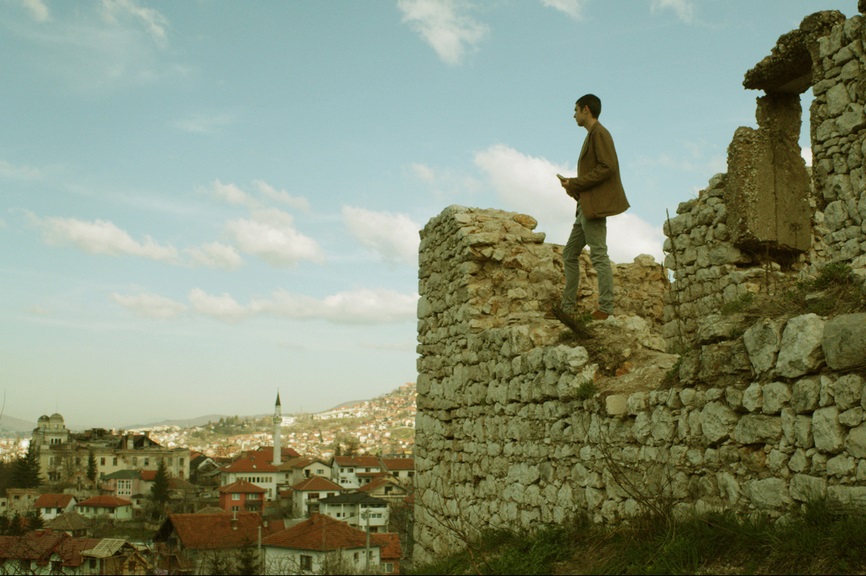Sarajevo – Civic Imagination for Reconstructing Citizenship
 |
| Film still - Bridges of Sarajevo © Cinétévé, Obala Art Centar, Bande à part Films, Mir Cinematografica, Ukbar, 2014. |
100 years ago, on 28 June 1914, Archduke Franz Ferdinand was inspecting Austrian troops in Sarajevo. To Serbs this was a provocation. The Archduke and his wife came near the Latin bridge face to face with their young Bosnian–Serbian murderer. The attack is considered to have triggered off the First World War. Sarajevo's very own catastrophe overcame the city around 80 years later: 1425 days, between 1992 and 1996, the city that is a melting pot of Catholics, Jews, Muslims and Orthodox Christians, was under siege by Bosnian–Serbian troops.
The bridges of Sarajevo gave way to the most tragic scenes of the civil war in the former Yugoslavia, with alcoholised Serbian snipers in the hills and the surrounding tower blocks killing old and young civilians at random. Nineteen years after the Dayton Peace Agreement, which put an end to the war in Bosnia and Herzegovina, at the cost of dividing the country into (artificially) ethnically defined cantons. The scars of this bureaucratic intervention still provide lots of problems on the political, economic, social as well as on the cultural level.
A completely fractured political system, with three presidents and dozens of ministers, designed by Western policymakers to bring a quick end to the Bosnian war only, resulted in a weak, and totally divided governmental structure with one of the poorest economies in the West. Unemployment amongst the active population is of gigantic proportions and is still rising. Youth employment stands at more than 60 percent. But most of those who do have jobs barely make money. The average net wage is 420 euros per month. And the country relies on, amongst other international finance, EU funding of about 100 million euros per year. However, landmine clearance of the country alone (an ongoing process that will last for at least another ten years –several hundred thousand antipersonnel landmines are still buried around Bosnia and Herzegovina) costs an average 30 million euros on an annual basis.
A lot of mines re-appeared with the catastrophic floods of last spring: a serious risk to recovery efforts. But at least the floods brought ethnic communities together, while the response of the authorities was almost non-existent. The national soccer team (a team of players scattered across the globe by the Bosnian war, and who qualified for the recent World Cup) remains de facto the only functioning multi-ethnic organization, due to the initiative of individual star players and die-hard soccer fans.
Thus, Bosnia-Herzegovina is not building on integration, but on further segregation, even in the school system. In the 'Republic' Srpska, one half of Bosnia-Herzegovina – in which the Bosnian Serbs make the policy – Bosniaks or Bosnian Muslims are taught in Serbian, Serbian culture and history. In the 'Federation' of Bosniaks and Croats – the other half of Bosnia-Herzegovina – many schools are divided: ‘two schools under one roof’, each with separate learning plans and barely any contact with each other.
In Bosnia- Herzegovina, corruption among business people and politicians alike is thriving. The competition between Russians, Turks, Saudis and Qataris to gain influence is growing. The US and the European community are more or less watching from the sidelines. The newly built Islamic library in the heart of Sarajevo was funded by the donations from Qatar. The Gazi Husrev-beg Library houses ancient Islamic manuscripts which were saved from destruction during the war by Bosnian residents, who hid them in different locations. The Dayton Peace Agreement left the status of national institutions unresolved in terms of governance and funding. The Serbian entity say that the responsibility for museums and other cultural institutions especially should fall to individual ethnic groups. Only very recently was the National Museum, which possesses the famed 600-year-old Jewish manuscript called ‘the Haggadah’, worth hundreds of millions of euros, reopened. The National Museum had been closed for many years due to lack of operational budget as a result of the political skirmishes between the different ethnic communities. Carol Duncan writes in Civilizing Rituals: Inside Public Art Museums that the historical and cultural achievement of museums lies essentially in the fact of having constructed a cultural and historical ritual that serves the formation and self-formation of the citizen. From this perspective the museum is not only, and maybe not even be primarily, the place for the exhibition of objects. Rather these objects function as tools for a ‘civilizing ritual’ for the individual. When people step into the museum, they don't want to step out of their lives. They want to get closer to them.
I spoke in the Great Hall of the Bosnian Parliament about art as a catalyst for social progress. I was invited by cultural producer, Haris Pašović who runs the fabled East West Center in Sarajevo. Haris founded the centre during the siege of the influential Sarajevo Film Festival. Thanks mainly to the cultural traffic of the festival, the city is now the homebase of influential Balkan filmmakers, such as: Jasmila Zbanic, Aida Begic and Oscar-winning Danis Tanovic. Pasovic had invited Susan Sontag to direct Waiting for Godot in the middle of the besieged city; Sontag stayed on for many more months. Pasovic’s company wants to raise awareness around multiculturalism in the Balkan region. He even plans a film about the national soccer-team, for which he is still looking for funding.
Haris had put the title of my lecture, ‘Everything can be changed’, on banners throughout the city. But it was my thesis that attracted most reactions in the local media and amongst the packed attendance: ‘Without culture we have even less’. I spoke about the necessity of civic imagination if one wants to construe citizenship anew. Through art one can struggle for something meaningful, an awareness of community. As such, art will become less a restrained container and more of an exuberant companion. I felt honoured by the presence of so many exciting Bosnian artists, such as Selja Kameric who created in 2003 the now legendary poster No teeth...? A mustache...? Smel like Shit...? Bosnian girl! based on a graffiti by an unknown Dutch soldier on a wall of the army barracks in Potocari, Srebrenica, around 1994–5. The Royal Netherlands Army troops, as part of the UN Protection Force in Bosnia and Herzegovina, were responsible for protecting the Srebrenica safe area. A photograph of the original graffiti is now in the Srebrenica Massacre Memorial Museum, initiated by photographer Tarik Samarah and realized with funding from Turkey. Samarah has been working on the project Srebrenica: Genocide at the heart of Europe for many years. He signed for me his photobook of the same title, writing ‘All that is necessary for the triumph of evil is that good men do nothing’, based on words by Edmund Burke.
It took me courage, being director of the soon-to-be-expanded Tate Modern in London, to state that Sarajevo should not want new big spaces for art – cultural progress and future cultural expressions in general will less and less depend on vast, glamorous buildings in one place anyhow, but instead invent new organizational and financial models in order to create a truly contemporary culture. I gave as examples the ‘communing’ of the commons and cultural participation. James B. Quilligan believes that virtually everyone recognizes the difference between private and public goods, yet the difference between two basic forms of collective property – public good and common good – are often confusing. The simplest way of contrasting a public and a common good is to ask: does this particular resource require management as a social mandate or is it an expression of a social mutuality and collaboration? The commons are based on inclusion and access, common goods are not commodities, they express a qualitative relationship. Cultural goods are common goods par excellence, and they are exceptional because of the conversation that makes them cultural goods. Culture is indeed a social software that is needed to manage the complexity of our societies.
And we have to learn to recognize the direct and indirect effects of cultural participation on innovation, welfare, health, social cohesion, soft power and the knowledge economy. There is a strong association between psychological well-being and cultural participation and even between life expectancy and cultural participation. As the economist Pierre Luigi Sacco has shown, active cultural participation stimulates the capability of people in terms of attitudes towards the un-experienced: questioning one's beliefs and world views, getting acquainted with cultural diversity, learning to appreciate the transformational impact of new ideas, building new expressive and conceptual skills, thus having a strong link with innovation. Without innovation there is no economic growth. Cultural participation has a remarkable direct micro-economic impact and a strong indirect macro-economic impact.
To make cultural participation really work there should be a blurred distinction between producers and receivers. People who know something meet up with people who know something else. Indeed, people flock to cultural institutions increasingly for social and knowledge experiences. At the last Film Festival in Cannes the collective film Bridges over Sarajevo was received with standing ovations: Jean-Luc Godard, Cristi Puiu, Teresa Villaverde, Aida Begic and other famous filmmakers paid, through short filmic contributions, homage to a city which once embodied a space for exchange between cultures and communities that in many ways prefigured the European construction. From having been there I became aware that this dream can be built up again: bit by bit through care of brilliant artists and tireless cultural producers. The audiences in Sarajevo are manifold, diverse and incredibly eager. I returned to Sarajevo in the summer of 2014 as a juror for the film festival. The festival flooded Sarajevo with culture and visitors from all over the Balkans. Indeed a genuine cultural understanding of regional cooperation has to be advocated. Mobility is the essence of regional cooperation, yet travelling to and from Sarajevo is still hard to do.
Since 27 March 2014, the British Embassy has introduced a new visa application scheme: the Priority Visa Scheme. The user charges are enormous. There is a charge of 59GBP to use the Visa Application Centre in addition to the visa fee. The Priority Visa Service is introduced at the cost of 100GBP. Temporary workers – creative and sporting, applicants sponsored by a company/institution listed on the UK Border's Agency approved Premium Sponsor list, are advised to apply through this service. The Visa Application Centre is located in the Hotel Europe, right around the corner from where the Archduke Franz Ferdinand was murdered on June 28 1914.
Chris Dercon, Director of Tate Modern, for Zamyn
© Zamyn and the author, all rights reserved. No reproduction, whether in whole or in part, without the prior written consent of Zamyn.



